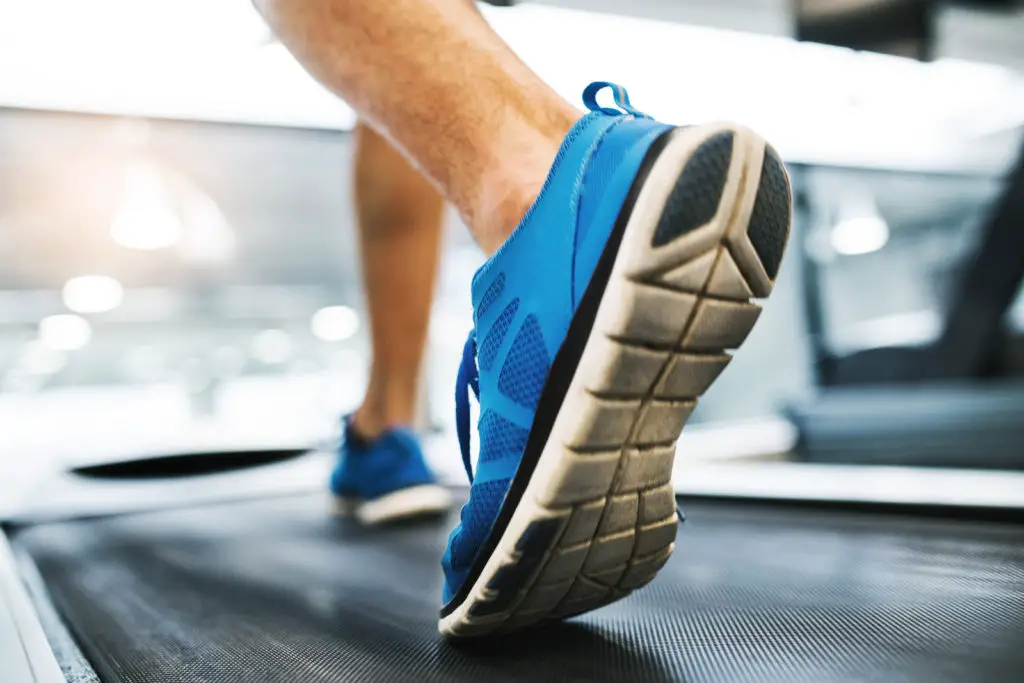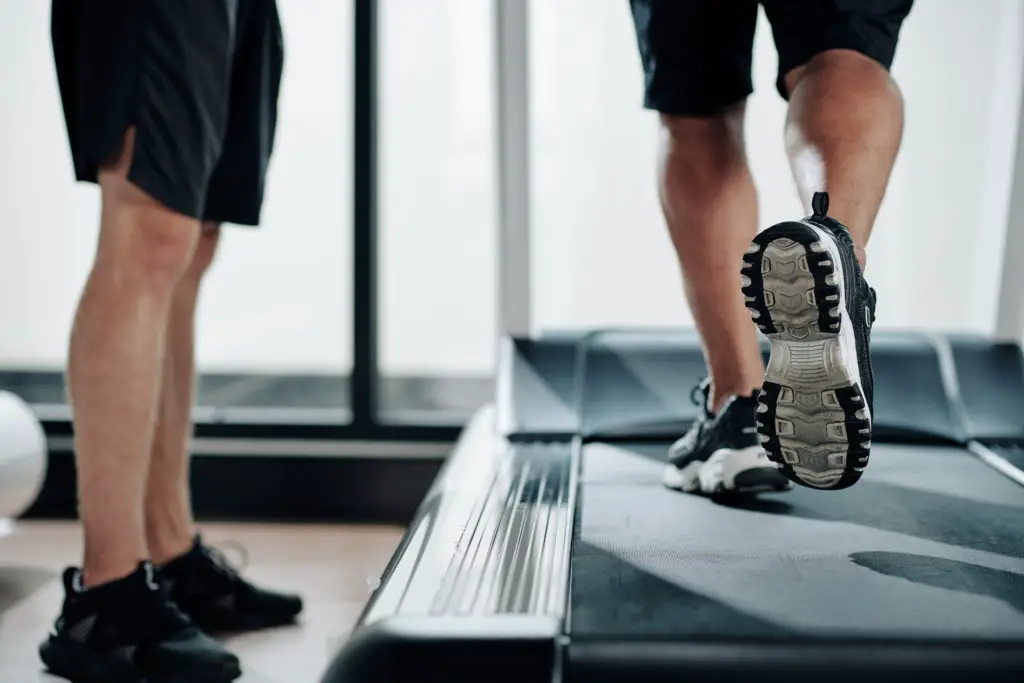
Whenever the word cardio is mentioned, the first thing that may come to mind is the treadmill. However, treadmills can be used for a multitude of different purposes, of which cardio is just one possibility. For those who are brand new to the treadmill, the first thing that should be established is a good treadmill speed.
A good treadmill speed is 5 mph. Although treadmill speed is highly relative to the individual, 5 mph is a good pace to elevate the heart rate, raise perspiration levels, and get some endorphins flowing. If this speed is consistently maintained, it will elicit results in the majority of individuals.
In this article, we will discuss how the treadmill works, proper running technique cues, and how different treadmill speeds affect your body physiologically. We will also be discussing the benefits of running on a treadmill vs. running outdoors or on a track, as well as who can stand to benefit from treadmill use. Lastly, we will be going over safety protocols when using the treadmill.
Page Contents
How Does a Treadmill Work: Explained

The treadmill is one of the most common pieces of gym equipment in existence. Treadmills can be found in the overwhelming majority of commercial gyms, as well as in many garage and basement home gyms. For those who prefer to run at home, the NordicTrack T Series is, without a doubt, the best unit on the market.
The treadmill relies on a moving conveyor belt where you run, walk or jog on. It can be adjusted for speed, as well as the level of incline. Treadmills vary in the amount of feedback they provide the user. Some of the more technologically advanced treadmills will display heart rate, distance traveled, pacing speed, calories burned, and the total time that has elapsed.
Possibly, the greatest appeal for most when it comes to the treadmill is that they are typically used indoors, allowing for climate control and a more comfortable workout. This is particularly convenient during the cold, harsh winter months when working out can seem especially daunting for some.
Safety Protocol When Using the Treadmill
When using the treadmill, it is critical to always take the appropriate safety measures in order to prevent injury to yourself, as well as others. Treadmill accidents happen fast and can result in very serious injury. Before beginning your exercise, the following considerations should always be made, so as to reduce potential risk factors:
- Make sure your shoelaces are properly tied and that no excessively loose clothing or jewelry is obstructing your movement or mobility.
- Identify where the stop button is located on the treadmill. This is typically a large, red button. Pressing this button at any time will immediately stop the belt.
- Attach the safety clip on the string to your shirt or shorts. This is to ensure that if you are to fall, the string will signal the belt to cease motion.
- Always use the hand rails when necessary to assist with getting on and off of the treadmill.
- Never increase the speed beyond your ability to manage. Always work within your limit and increase speed slowly in order to give yourself time to gauge, as treadmill speed increases often have a slightly delayed onset.
As long as these precautions are taken, you will remain safe while using the treadmill.
Treadmill Benefits

Due to its endless list of positive offerings, people from all walks of life can stand to benefit from frequenting the treadmill. It is not uncommon to find that the elderly, as well as team sport athletes, marathon runners and sprinters, bodybuilders, powerlifters, boxers, and aspiring weight loss clients all consider the treadmill to be a staple of their training routine.
Treadmills have been used in order to attain a wide range of goals, some of which often include:
- Weight loss
- Improving cardiovascular health
- Cutting weight for a class-based competition, such as weightlifting or martial arts
- Recovery from injuries, surgeries, and for prehabilitation
Running Technique
Running technique will always be individual to some extent. This is because we all have different bodily proportions and limb lengths that alter our stride length and width, as well as our center of gravity.
However, there are a few universal technical cues which should be followed by all:
- Do not plant violently. Avoid landing on your heels or toes. Instead, gently place the middle of your foot down, and drive through the ground using your quadriceps to perform every step. Overly aggressive stomping leads to excessive skeletal shock and can injure your knees and spine over time.
- Do not over-stride. In other words, do not extend your steps too far out in front of you. This often leads to heel striking.
- Breathe rhythmically. Synchronize your steps with your breaths. For example, in the first two steps, you will inhale, and in the next two, you shall exhale. This would be known as a 2-2 breathing pattern. However, some runners may prefer a different variation.
Treadmill vs. Track Running
Oftentimes, individuals who have spent a fair amount of time running on the treadmill will find transitioning to the street difficult at first, and vice versa. There are many carryovers between the two styles, such as cardiovascular improvement and muscular endurance. However, with the treadmill, the ground is moving towards you, and on the road you toward it, it tends to be off-putting at first.
When transitioning from one to the other, allow your body time to adjust and do not try to force out the same amount of mileage you were previously able to achieve. Failure to adapt properly may lead to stress, injury, and regression.
If you’d like to have an in-depth comparison between running on the treadmill and running outside, check out this blog post.
How Treadmill Speed Affects Your Body

Different treadmill speeds engage different physiological systems of the body and elicit very different results. When running at near maximal speeds, a pace that can only be maintained for 10-100 seconds, the body uses what is known as the anaerobic system. The benefit of this is that the high level of exertion tears down a lot of muscle fibers, creating a hypertrophic, mass build effect.
When running at a moderate pace, a maintainable pace in excess of 2 minutes, the aerobic system is the primary contributor. This is great for muscular endurance, cardiovascular endurance, and less intense, allowing for greater ease of recovery.
Ideal Treadmill Speed
What constitutes a good treadmill speed will differ from person to person, relative to their fitness level, age, and past exercise history. However, when first starting out, it is vital that the exerciser starts at a modest pace in order to adapt their body accordingly.
Five miles per hour is right around the speed where walking becomes jogging, so assuming the incline is neutral, this is a good treadmill speed for the average trainee just looking to see results.
Conclusion
Treadmill training has enough benefits to write an entire book on. It has the capability of providing results unrivaled by any other single piece of cardio equipment. Some will go as far as to say any gym which lacks a treadmill is no gym at all, a claim which is tough to argue against.
However, the purpose of this article was to provide some background information to determine what is a good speed to operate the treadmill. For the average person, who is relatively untrained but has some base level of fitness, anything around 5 mph is a good speed. At this rate, the treadmiller will be able to produce respectable results while simultaneously lessening the chance of injury and overtraining.
Always be respectful to your body, work within your ability, be mindful of the safety protocols, and have fun!
